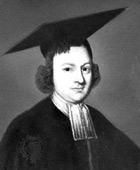Christopher Smart was born in 1722 in Shipbourne, Kent, England. His father, a steward on the estate of Lord Vane, died when Smart was eleven. Smart attended the Durham School and was later educated at Pembroke College, Cambridge University, where he was well known for his Latin verses. The Odes of Horace would remain influential throughout Smart's career; he translated The Works of Horace in 1756. After college, Smart earned a living in London editing and writing copy for periodicals and composing songs for the popular theater. During this time, he became known for his reckless drinking and spending habits; he was arrested for debt in 1747. In 1752 he published his first collection, Poems on Several Occasions, and married Anna Maria Carnan. They had two daughters.
In the 1750s Smart developed a form of religious mania that compelled him to continuous prayer. Samuel Johnson remarked, "My poor friend Smart showed the disturbance of his mind by falling upon his knees, and saying his prayers in the street, or in any other unusual place." In 1756 he published Hymn to the Supreme Being, on Recovery from a Dangerous Fit of Illness. However, from that time onward, Smart was confined, with one brief Intermission, until 1763 in St. Luke's Hospital and then in Mr. Potter's Madhouse in Bethnal Green. During his confinement he wrote what many see as his most original and lasting works—A Song to David, and the lengthy manuscript of Jubilate Agno. The last five years of Smart's life were marked by increasing debt and need; he was arrested again for debt in 1770 and died the following year.
Smart is best known for A Song to David (1763), which praises the author of the Psalms as an archetype of the Divine poet. Although in its own time the poem was greeted largely with confusion, later poets such as Browning and Yeats would single out this poem for its affirmation of spirituality in an increasingly materialistic world. In this respect Smart has been considered as a forerunner to poets such as John Clare and William Blake. Smart is also known for his distinctive and often anthologized homage to his cat, Jeoffry. This poem comes from the surviving fragments of Jubilate Agno, which was also written during his confinement but not published in a definitive edition until 1954. The surviving fragments of Jubilate Agno are composed in a series of antiphonal verses beginning either with the word let or for. Smart envisions himself as "the Lord's News-Writer—the scribe-evangelist" spreading the Word. The poem is both a personal and philosophical diary and it presents an encyclopedic gathering of obscure lore, genealogy, and wordplay. Startling alterations of tone and juxtaposition of material as well as a careful attention to the quotidian energize Jubilate Agno. Smart's work has captured the attention of contemporary artists such as Benjamin Britten, Allen Ginsberg, and Theodore Roethke. |






